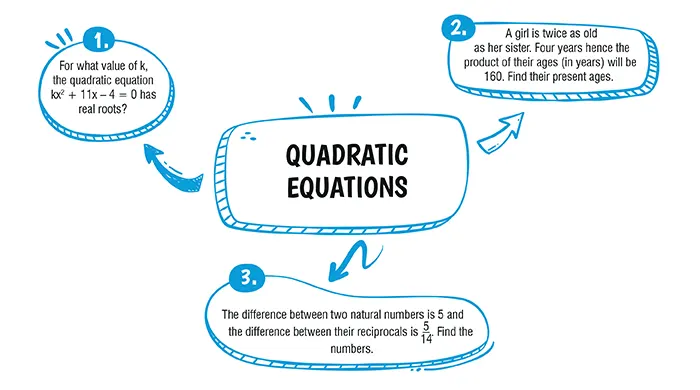Table of Contents

Ans. (a)
Explanation:
Given, \space\space\space\space 2x^2 + x - 1 = 0 \\ [4.5 bp]
⇒ 2x^2 + 2x - x - 1 = 0 \\ [4.5 bp]
⇒ 2x (x + 1) - 1 (x + 1) = 0 \\[4.5 bp]
⇒ (x + 1)(2x - 1) = 0 \\[4.5 bp]
⇒ \text{x = -1 or x =}{\Large\frac{1}{2}} \\ [4.5 bp]
\text{Hence roots of equation are -1 and }{\Large\frac{1}{2}}
Ans. (c)
Explanation:
For a given equation to have equal roots
D = 0,
\space\space\space\space\space D = b^2 - 4ac
i.e.
Here, b = p, a = 2, c = 3
⇒ p^2 - 4 × 2 × 3 = 0 \\ [4.5 bp]
⇒ p^2 - 24 = 0 \\ [4.5 bp]
⇒ \text{p = } \pm \sqrt{24} = \pm 2\sqrt{6} \\ [4.5 bp]
\text{Hence, for} \space p = \pm 2\sqrt{6} \space
\text{the given equation has equal roots.}
Explanation:
Given quadratic equation is
Explanation:
Let the sister’s age be x. Thus, the girl’s age is 2x.
Four years hence,
Sister’s age = (x + 4)
and Girl’s age = (2x + 4)
Now (x + 4) (2x + 4) = 160
⇒ 2x^2 + 8x + 4x + 16 = 160 \\ [4.5 bp]
⇒ 2x^2 + 12x + 16 = 160 \\[4.5 bp]
⇒ 2x^2 + 12x – 144 = 0 \\[4.5 bp]
⇒ x^2 + 6x – 72 = 0 \\[4.5 bp]
⇒ x^2 + 12x – 6x – 72 = 0 \\[4.5 bp]
⇒ x(x + 12) – 6(x + 12) = 0 \\[4.5 bp]
⇒ (x + 12) (x – 6) = 0 \\[4.5 bp]
⇒ x = 6 \space or \space – 12 \\[4.5 bp]
⇒ x = 6
(as age is always positive)
Thus, the sister’s age is 6 years and the girl’s age is 2 × 6 = 12 years.
Explanation:
Let the natural numbers be x and 5 + x respectively.
According to the question,
\frac{1}{x} – \frac{1}{x+5} = \frac{5}{14} \\ [4.5 bp]
⇒ 14(x+5) – 14x = 5x(x+5)
⇒ 5x^2 + 25x = 70 \\ [4.5 bp]
⇒ x^2 + 5x - 14 = 0 \\ [4.5 bp]
⇒ x^2 + 7x - 2x - 14 = 0 \\ [4.5 bp]
⇒ x(x + 7) - 2(x + 7) = 0
⇒ (x + 7) (x - 2) = 0
⇒ (x + 7) (x - 2) = 0
⇒ x = 2, – 7
Since natural numbers cannot be –ve, so x = 2 and x + 5 = 2 + 5 = 7
So, the two numbers are 7 and 2.
| Chapter No. | Chapter Name |
|---|---|
| Chapter 1 | Real Numbers |
| Chapter 2 | Polynomials |
| Chapter 3 | Pair of Linear Equations in Two Variable |
| Chapter 4 | Quadratic Equations |
| Chapter 5 | Arithmetic Progressions |
| Chapter 6 | Triangles |
| Chapter 7 | Coordinate Geometry |
| Chapter 8 | Introduction to Trigonometry |
| Chapter 9 | Some Applications of Trigonometry |
| Chapter 10 | Circles |
| Chapter 11 | Areas Related to Circle |
| Chapter 12 | Surface Areas and Volumes |
| Chapter 13 | Statistics |
| Chapter 14 | Probability |
Ans: You can determine the number of solutions by looking at the value of the discriminant:
| Chapter Wise Important Questions for CBSE Board Class 10 Maths |
|---|
| Real Numbers |
| Polynomials |
| Pair of Linear Equations in Two Variables |
| Quadratic Equations |
| Arithmetic Progressions |
| Triangles |
| Coordinate Geometry |
| Introduction to Trigonometry |
| Some Applications of Trigonometry |
| Circles |
| Areas Related to Circles |
| Surface Areas and Volumes |
| Statistics |
| Probability |
CBSE Important Questions Class 10
ICSE Important Questions Class 10
CBSE Important Questions Class 10
ICSE Important Questions Class 10